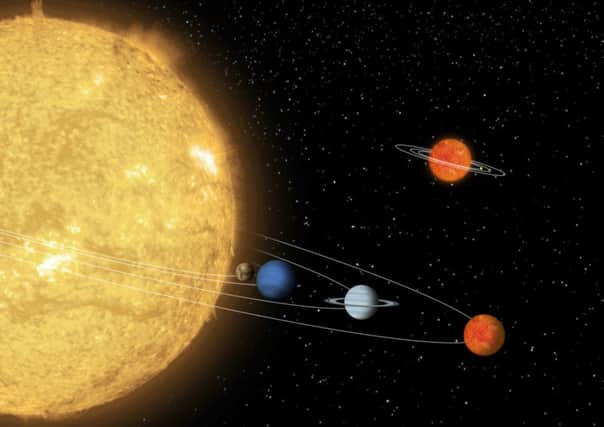Scots research could dig up life on other planets


They claim that cold rocky planets, the size of Earth which were previously considered uninhabitable, may actually be able to support life beneath the surface. And they could support life at least ten times further away from stars than previously thought.
The new study, headed by academics at Aberdeen University, has been published in the scientific journal Planetary and Space Science.
Advertisement
Hide AdAdvertisement
Hide AdA spokesman for Aberdeen University said: “The team challenge the traditional ‘habitable zone’ – i.e. the area of space around a star, or sun, which can support life – by taking into consideration life living deep below the ground.”
Sean McMahon, a PhD student who was part of the research team, explained: “The traditional habitable zone is also known as the ‘Goldilocks’ zone.
“A planet needs to be not too close to its sun but also not too far away for liquid water to persist, rather than boiling or freezing, on the surface. But that theory fails to take into account life that can exist beneath a planet’s surface. As you get deeper below a planet’s surface, the temperature increases, and once you get down to a temperature where liquid water can exist – life can exist there too.”
The research team created a computer model that estimates the temperature below the surface of a planet of a given size, at a given distance from its star.
Mr McMahon said: “The deepest known life on Earth is 5.3km below the surface, but there may well be life even 10km deep in places on Earth that haven’t yet been drilled. Using our computer model we discovered that the habitable zone for an Earth-like planet orbiting a sun-like star is about three times bigger if we include the top five kilometres below the planet surface.
“The model shows that liquid water, and as such life, could survive 5km below the Earth’s surface even if the Earth was three times further away from the sun than it is just now.”
He continued: “If we go deeper, and consider the top 10km below the Earth’s surface, then the habitable zone for an Earth-like planet is 14 times wider. The current habitable zone for our solar system extends out as far as Mars, but this re-drawn habitable zone would see the zone extend out further than Jupiter and Saturn. The findings also suggest that many of the so-called ‘rogue’ planets drifting around in complete darkness could actually be habitable.”
Mr McMahon added: “Rocky planets a few times larger than the Earth could support liquid water at about 5km below the surface even in interstellar space - even if they have no atmosphere because the larger the planet, the more heat they generate internally.
Advertisement
Hide AdAdvertisement
Hide Ad“It has been suggested that the planet Gliese 581 d, which is 20 light years away from Earth in the constellation Libra, may be too cold for liquid water at the surface. However, our model suggests that it is very likely to be able to support liquid water less than 2km below the surface, assuming it is Earth-like.”
Mr McMahon said he hoped the findings would encourage other researchers to consider how life on other planets might be detected.
He explained: “The results suggest life may occur much more commonly deep within planets and moons than on their surfaces. This means it might be worth looking for signs of life outside conventional habitable zones.
“The surfaces of rocky planets and moons that we know of are nothing like Earth. They’re typically cold and barren with no atmosphere or a very thin or even corrosive atmosphere. Going below the surface protects you from a whole host of unpleasant conditions on the surface. So the subsurface habitable zone may turn out to be very important. Earth might even be unusual in having life on the surface.”